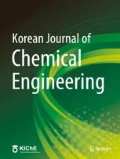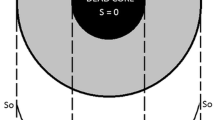Abstract
Transient responses of immobilized enzyme reactors were obtained by solving coupled governing equations for core-shell catalytic pellets. The morphology of the pellets was assumed as sphere, cylinder, and slab-type particles having inert cores. Nonlinear reaction-diffusion equations of batch-mode reaction systems were solved by finite element method using commercial software, COMSOL Multiphysics, to investigate the effect of adjustable parameters such as thickness of inert core, Biot number, and the amount of pellets as well as reaction parameters of Michaelis-Menten kinetics. Modeling of CSTR was also carried out and the results were compared with the transient response of batch reactor by adjusting retention time during numerical calculations, reflecting deactivation of enzyme as time-dependent rate constant. For both types of reactors, spherical pellets were the most advantageous for reduction of reactant concentration with relatively smaller effect of the thickness of inert core, compared to other types of pellets. Additionally, a number of connected CSTRs were assumed for approximate analysis of fixed bed reactor, of which the behavior became close to a simple CSTR with increasing axial dispersion.
Similar content being viewed by others
References
S. Datta, L. R. Christena and Y. R. S. Rajaram, 3 Biotech, 3, 1 (2013).
A. Basso and S. Serban, Mol. Catal., 479, 110607 (2019).
A. S. Simões, L. Ramos, L. Freitas, J. C. Santos, G. M. Zanin and H. F. de Castro, Biofuel Res. J., 6, 242 (2015).
B. Wouters, S. A. Currivan, N. Abdulhussain, T. Hankemeier and P. J. Schoenmakers, Trends Anal. Chem., 144, 116419 (2021).
C. B. Ching and K. H. Chu, Appl. Microbiol. Biotechnol., 29, 316 (1988).
I. M. Abu-Reesh, Bioprocess Eng., 17, 131 (1997).
A. Illanes, L. Wilson and L. Raiman, Bioprocess Eng., 21, 509 (1999).
J. G. Palencia and E. M. Verruschi, Chem. Eng. Trans., 27, 379 (2012).
A. Ghadi, F. Tabandeh, S. Mahjoub, A. Mohsenifar, F. T. Roshan and R. S. Alavije, J. Oleo Sci., 64(4), 423 (2015).
L. Li, Z. Gao, H. Zhang, H. Du, C. Ren, S. Qi and H. Chen, New J. Chem., 45, 11153 (2021).
R. Varshney, S. Sharma, B. Prakash, J. K. Laha and D. Patra, ACS Omega, 4, 13790 (2021).
Z. Gan, T. Zhang, Y. Liu and D. Wu, Plos One, 7(10), e47154 (2012).
M. Moo-Young and T. Kobayashi, Can. J. Chem. Eng., 50, 162 (1972).
N. E. Moreira and F. X. Malcata, J. Chem. Eng. Jpn., 29(2), 392 (1996).
V. Bales and P. Rajniak, Chem. Papers, 40(3), 329 (1986).
A. E. AL-Muftaha and I. M. Abu-Reesh, Biochem. Eng. J., 23, 139 (2005).
P. Valencia, S. Flores, L. Wilsona and A. Illanes, Biochem. Eng. J., 49, 256 (2010).
R. Fraas and M. Franzreb, Biocatal. Biotransfor., 35(5), 337 (2017).
S. H. Lin and C. K. Wei, Chem. Eng. Sci., 34, 827 (1979).
S. Hertzberg, L. Kvittingen, T. Anthonsen and G. Skjåk-Braek, Enzyme Microb. Technol., 14(1), 42 (1992).
G. Xiu, L. Jiang and P. Li, Ind. Eng. Chem. Res., 39(11), 4054 (2000).
S. H. Lin, Biophys. Chem., 8, 105 (1978).
P. De Santis, L.-E. Meyer and S. Kara, React. Chem. Eng., 5, 2155 (2020).
A. Sanchez, J. Cruz, N. Rueda, J. C. S. dos Santos, R. Torres, C. Ortiz, R. Villalonga and R. Fernandez-Lafuente, RSC Adv., 6, 27329 (2016).
G. Pettersson, Eur. J. Biochem., 69, 273 (1976).
Y. Hayashi, S. Santoro, Y. Azuma, F. Himo, T. Ohshima and K. Mashima, J. Am. Chem. Soc., 135, 6192 (2013).
Y.-S. Cho and S. Sung, Korean J. Chem. Eng., 37(11), 1836 (2020).
U. Mehmetoglu, Enzyme Microb. Technol., 12, 124 (1990).
P. Li, G. Xiu and A. E. Rodrigues, Chem. Eng. Sci., 58, 3361 (2003).
S. H. Lin, J. Appl. Chem. Biotechnol., 28, 677 (1978).
J. O. M. Rosa, R. M. Escobar, T. V. Garcia and J. A. Ochoa-Tapia, Chem. Eng. Sci., 57, 1409 (2002).
M. E. Maria and M. B. Mansur, Braz. J. Chem. Eng., 34(3), 901 (2017).
Acknowledgements
This research was supported by Priority Research Centers Program through the National Research Foundation of Korea (NRF) funded by the Ministry of Education (NRF-2017R1A6A1A03015562), the National Research Foundation of Korea (NRF) grant funded by the Korea government (MSIT) (No. 2021R1F1A1047451), and Korea Institute for Advancement of Technology (KIAT) grant funded by the Korea Government (MOITIE, P0002007, The Competency Development Program for Industry Specialist).
Author information
Authors and Affiliations
Corresponding author
Rights and permissions
About this article
Cite this article
Cho, YS. Transient response of immobilized enzyme reactors - the effects of reactor type and shape of core-shell bio-catalytic pellets. Korean J. Chem. Eng. 39, 2275–2290 (2022). https://doi.org/10.1007/s11814-022-1174-4
Received:
Revised:
Accepted:
Published:
Issue Date:
DOI: https://doi.org/10.1007/s11814-022-1174-4




